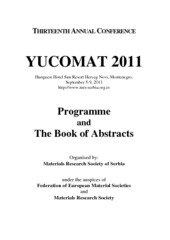Приказ основних података о документу
Sintering of defect-free functionally graded biomaterials
| dc.creator | Marković, Smilja | |
| dc.creator | Lukić, Miodrag J. | |
| dc.creator | Škapin, Srečo Davor | |
| dc.creator | Uskoković, Dragan | |
| dc.date.accessioned | 2017-06-10T15:45:07Z | |
| dc.date.issued | 2011 | |
| dc.identifier.uri | https://dais.sanu.ac.rs/123456789/684 | |
| dc.description.abstract | Functionally graded materials (FGMs) with a gradient of chemical, electrical, mechanical and/or biological properties are very attractive because of their superior features compared to conventional materials. It is known that implanted hydroxyapatite (HAp) scaffolds with a porosity gradient which mimicked the architecture of natural bone, induce rapid bone ingrowths into the high-porosity portion and withstand physiological mechanical stresses through the lowporosity region. Here, three, four and five component hydroxyapatite functionally graded materials (HAp-FGMs) were designed and examined. HAp powders with different stoichiometry denoted as SHAp (stoichiometric, Ca/P = 1.67) and CDHAp (calcium defficient, Ca/P = 1.62) were used. These two powders were chosen since they show different sinterability in the same sintering conditions, yielding different microstructure (density and average grain size) and also mechanical properties which is necessary for tailoring of appropriate functionally graded biomaterials. It is known that during sintering of FGMs composed of powders which show different shrinkage extents, as well as different final density, excessive shape distortion, warping, delamination, cracks and microstructural damages in the FGMs could be produced. Thus, to achieve high-quality graded biomaterials with appropriate functionality without above listed disadvantages, we applied moderate sintering conditions through two step sintering (TSS) process. Furthermore, TSS method was chosen since significantly improved microstructural characteristics of HAp and BCP could be obtained. So, layered samples, produced by powderstacking method and uniaxially-pressing process, were transformed in HAp-FGMs by TSS: the samples were heated up to 900 ◦C and after retention for 5 min the samples were cooled down to 850 ◦C and kept for 20 h. The microstructure and Ca/P ratio of the prepared HAp-FGMs were examined by FESEM and EDS methods; mechanical characteristics were analyzed by nanoindentation. | en |
| dc.format | (2011) 8-8 | |
| dc.format | application/pdf | |
| dc.language | en | |
| dc.publisher | Belgrade : Materials Research Society of Serbia | |
| dc.relation | info:eu-repo/grantAgreement/MESTD/Integrated and Interdisciplinary Research (IIR or III)/45004/RS// | |
| dc.rights | openAccess | |
| dc.rights.uri | https://creativecommons.org/licenses/by-nc-nd/4.0/ | |
| dc.source | The Thirteenth Annual Conference YUCOMAT 2011: Programme and the Book of Abstracts | en |
| dc.subject | functionally graded materials | |
| dc.subject | hydroxyapatite | |
| dc.subject | sintering | |
| dc.title | Sintering of defect-free functionally graded biomaterials | en |
| dc.type | conferenceObject | |
| dc.rights.license | BY-NC-ND | |
| dcterms.abstract | Марковић, Смиља; Лукић, Миодраг; Шкапин, Сречо Давор; Ускоковић, Драган; | |
| dc.citation.spage | 8 | |
| dc.citation.epage | 8 | |
| dc.type.version | publishedVersion | |
| dc.identifier.fulltext | https://dais.sanu.ac.rs/bitstream/id/21651/681.pdf | |
| dc.identifier.rcub | https://hdl.handle.net/21.15107/rcub_dais_684 |

